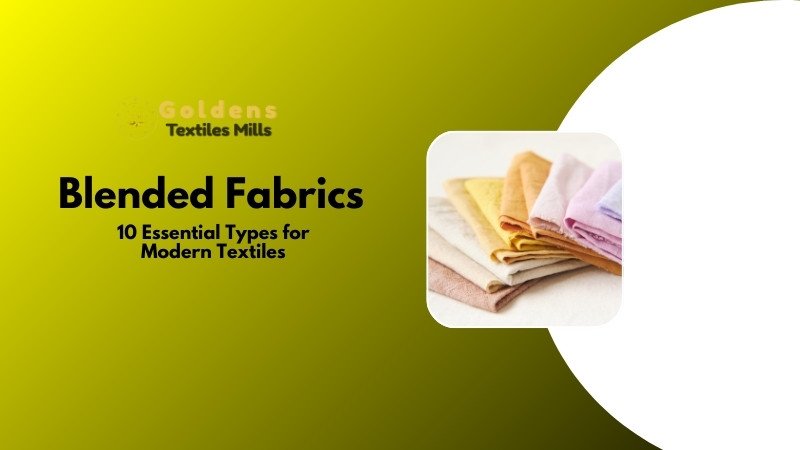Blended fabrics have revolutionized the textile industry by combining the best properties of different fibers to create superior materials that outperform single-fiber fabrics. These innovative combinations offer enhanced durability, comfort, and functionality while often reducing costs and environmental impact. This comprehensive guide explores the 10 most essential blended fabrics that are transforming modern textiles.
Table of Contents
- Introduction to Blended Fabrics
- 1. Polyester-Cotton Blends
- 2. Cotton-Viscose Blends
- 3. Polyester-Viscose Blends
- 4. Cotton-Silk Blends
- 5. Polyester-Wool Blends
- 6. Cotton-Linen Blends
- 7. Modal Blended Fabrics
- 8. Bamboo Blended Fabrics
- 9. Spandex Blended Fabrics
- 10. Sustainable Fiber Blends
- Manufacturing Process
- Advantages of Blended Fabrics
- Future Trends in Blended Textiles
- Conclusion
Introduction to Blended Fabrics
Blended fabrics represent the perfect marriage of different fiber types, combining the breathability and comfort of natural materials with the durability and easy-care properties of synthetics. The textile industry has mastered the art of creating these hybrid textiles, producing some of the world's finest blended fabrics that serve diverse applications from fashion to industrial use.
The strategic blending of fibers allows manufacturers to enhance specific properties while minimizing drawbacks of individual components. For instance, adding polyester to cotton increases strength and reduces wrinkling, while maintaining much of cotton's breathability and moisture absorption.
1. Polyester-Cotton Blends
The most popular and versatile blended fabric is the polyester-cotton (poly-cotton) blend, typically in ratios ranging from 65/35 to 50/50. These fabrics combine cotton's breathability with polyester's wrinkle resistance and durability.
Key Properties
Poly-cotton blends offer excellent durability, minimal shrinkage, and good moisture management. They're easier to care for than 100% cotton while providing better comfort than 100% polyester.
Common Applications
These versatile blends are used in everyday clothing, uniforms, bedding, and workwear. The specific ratio can be adjusted to prioritize either comfort (higher cotton content) or durability (higher polyester content).
2. Cotton-Viscose Blends
Cotton-viscose blends combine natural cotton fibers with semi-synthetic viscose (rayon) to create fabrics with exceptional drape and softness while maintaining good moisture absorption.
Key Properties
These blends offer a silky feel with enhanced breathability and moisture-wicking capabilities. They typically have better drape than pure cotton and better durability than pure viscose.
Common Applications
Cotton-viscose blends are particularly popular for women's wear, casual shirts, and lightweight dresses where comfort and elegant drape are priorities.
3. Polyester-Viscose Blends
Polyester-viscose blends (often with a small percentage of elastane) combine the strength of polyester with the comfort and drape of viscose, creating versatile fabrics for formal and business wear.
Key Properties
These blends offer excellent wrinkle resistance, shape retention, and a smooth, luxurious hand feel. They're more durable than pure viscose while offering better drape than pure polyester.
Common Applications
These fabrics are widely used in formal wear, particularly for trousers, skirts, and suits. The addition of elastane (typically 2-5%) enhances comfort and recovery.
4. Cotton-Silk Blends
Cotton-silk blended fabrics offer the luxury of silk with the practicality and comfort of cotton, creating premium textiles with unique properties.
Key Properties
These blends provide the lustrous appearance and smooth feel of silk while being more durable, easier to care for, and more affordable than pure silk fabrics.
Common Applications
Cotton-silk blends are used in high-end traditional wear, formal shirts, and decorative home textiles where a touch of luxury is desired without the high maintenance of pure silk.

5. Polyester-Wool Blends
Polyester-wool blends offer the warmth and appearance of wool with enhanced durability and easier care, making them practical for everyday formal wear.
Key Properties
These blends resist wrinkles better than pure wool, are less prone to shrinking, and typically cost less. They maintain much of wool's insulating properties while adding durability and wash-and-wear convenience.
Common Applications
Polyester-wool blends are primarily used in suiting, outerwear, and winter clothing. Common ratios include 55/45 and 65/35 polyester/wool for optimal performance.
6. Cotton-Linen Blends
Cotton-linen blends combine the coolness and crispness of linen with the softness and wrinkle resistance of cotton, creating ideal fabrics for warm weather.
Key Properties
These blends wrinkle less than pure linen while offering better breathability than pure cotton. They provide excellent moisture absorption and heat dissipation for comfort in hot conditions.
Common Applications
Cotton-linen blends are perfect for summer clothing, casual shirts, dresses, and lightweight home textiles like curtains and tablecloths.
7. Modal Blended Fabrics
Modal, a type of rayon made from beech trees, is often blended with cotton, polyester, or spandex to create exceptionally soft and durable fabrics.
Key Properties
Modal blends offer extraordinary softness, excellent color retention, and high resistance to shrinkage. They're typically more durable than similar viscose blends and maintain their softness through repeated washing.
Common Applications
Modal blends are popular for underwear, loungewear, bedding, and high-end t-shirts where softness against the skin is paramount.

8. Bamboo Blended Fabrics
Bamboo viscose (often marketed simply as bamboo) is frequently blended with cotton, polyester, or spandex to create fabrics with unique properties.
Key Properties
Bamboo blends offer exceptional softness, natural UV protection, and excellent moisture management. They're known for their silky feel and natural antibacterial properties.
Common Applications
Bamboo blends are increasingly popular for activewear, underwear, socks, and bedding, particularly for consumers with sensitive skin or environmental concerns.
9. Spandex Blended Fabrics
Spandex (elastane) is rarely used alone but is blended in small percentages (2-10%) with other fibers to add stretch and recovery to fabrics.
Key Properties
Spandex blends offer excellent stretch and recovery, shape retention, and comfort during movement. Even small percentages of spandex can dramatically improve a fabric's performance.
Common Applications
Cotton-spandex, polyester-spandex, and nylon-spandex blends are used extensively in activewear, jeans, underwear, and any garment where comfort and movement are priorities.
10. Sustainable Fiber Blends
Emerging sustainable blends combine recycled polyester, organic cotton, Tencel® (lyocell), and other eco-friendly fibers to create environmentally responsible textiles.
Key Properties
These innovative blends offer reduced environmental impact while maintaining or improving upon the performance of conventional blends. Many feature biodegradable components or recycled content.
Common Applications
Sustainable blends are increasingly used across all textile categories, from fashion to home textiles, particularly by brands with strong environmental commitments.
Our Blended Fabric Manufacturing Capabilities
At Golden Textile Mills, we employ state-of-the-art technology and rigorous quality control processes to produce premium blended fabrics:
Advanced Blending Technology
Our precision blending equipment ensures consistent fiber distribution for optimal performance.
Modern Spinning Units
High-speed spinning frames produce uniform yarns from our carefully blended fibers.
Versatile Weaving Department
Our looms can create a wide range of weaves and textures for diverse applications.
Comprehensive Quality Testing
Every batch of blended fabric undergoes rigorous testing for strength, colorfastness, and dimensional stability.
Advantages of Blended fabrics
Blended fabrics offer numerous advantages over single-fiber textiles:
- Enhanced Performance: Combining fibers creates materials with superior properties that single fibers cannot achieve alone
- Cost Efficiency: Blending expensive fibers with more affordable ones reduces overall costs while maintaining quality
- Improved Durability: Many blends last longer than their single-fiber counterparts
- Better Comfort: Strategic blending can enhance breathability, moisture management, and next-to-skin feel
- Easier Care: Many blends require less maintenance than pure natural fibers
- Resource Efficiency: Blending can reduce dependence on resource-intensive fibers
- Versatility: Adjusting blend ratios allows manufacturers to create fabrics optimized for specific applications
Frequently Asked Questions About Blended Fabrics
What is the difference between blended fabrics and pure fabrics?
Blended fabrics combine two or more different fiber types to create a textile with enhanced properties, while pure fabrics consist of only one fiber type. Blends typically offer improved performance characteristics such as better durability, easier care, or enhanced comfort compared to their pure counterparts.
Are blended fabrics more durable than pure fabrics?
In many cases, yes. Blended fabrics often incorporate synthetic fibers like polyester or nylon that add strength and abrasion resistance to natural fibers. For example, a poly-cotton blend typically lasts longer than 100% cotton while maintaining much of cotton's comfort and breathability.
How do I care for blended fabrics?
Care instructions depend on the specific blend, but most blended fabrics are designed to be easier to maintain than pure natural fibers. Generally, machine washing in cold or warm water and tumble drying on low heat is suitable for common blends like poly-cotton. Always check the garment's care label for specific instructions based on the exact fiber composition.
Are blended fabrics environmentally friendly?
The environmental impact varies widely depending on the specific fibers in the blend. Traditional synthetic components like polyester have a higher carbon footprint, but modern sustainable blends incorporating recycled polyester, organic cotton, or biodegradable fibers like Tencel® offer significantly improved environmental credentials. At Golden Textile Mills, we're increasingly focusing on eco-friendly blended options.
Which blended fabric is best for hot weather?
Cotton-linen blends are excellent for hot weather, combining linen's exceptional cooling properties with cotton's softness and reduced wrinkling. Bamboo blends also perform well in hot conditions due to their moisture-wicking capabilities and breathability. For activewear in hot weather, polyester-spandex blends with moisture management technology are ideal.
Can blended fabrics cause allergic reactions?
Blended fabrics are generally less likely to cause allergic reactions than some pure fabrics, as the blending process can reduce the concentration of potential allergens. However, individuals with specific sensitivities should check the fiber content. Those with synthetic fiber sensitivities might prefer natural-fiber blends like cotton-modal or cotton-silk.
Future Trends in Blended Textiles
The future of blended fabrics is being shaped by several key trends:
Smart Textiles Integration
Blended fabrics are becoming the foundation for smart textiles, with conductive fibers woven into traditional blends to create fabrics that can monitor health metrics, regulate temperature, or change appearance.
Biodegradable Synthetics
New biodegradable synthetic fibers are being developed to create blends that maintain performance while reducing environmental impact at end-of-life.
Circular Economy Focus
Innovations in fiber separation technology are making it easier to recycle blended fabrics, supporting the textile industry's shift toward circular economy principles.
Performance Optimization
Advanced computational modeling is enabling the development of precisely engineered blends with optimized performance characteristics for specific applications.
Conclusion
Blended fabrics represent one of the most significant innovations in textile manufacturing, offering combinations of properties that would be impossible to achieve with single-fiber materials. By strategically combining different fiber types, manufacturers can create textiles that are stronger, more comfortable, more functional, and often more sustainable than their pure counterparts.
As technology advances and consumer preferences evolve, we can expect to see even more innovative blends that push the boundaries of textile performance while addressing growing concerns about sustainability and resource efficiency.
Whether you're a fashion designer seeking the perfect material for your next collection, a manufacturer looking to optimize your product line, or simply a consumer wanting to make informed choices about the fabrics in your life, understanding the properties and applications of different blended fabrics is increasingly essential in our textile-rich world.
Golden Textile Mills: Your Blended Fabric Specialist
At Golden Textile Mills, we specialize in manufacturing premium blended fabrics that combine the best properties of different fibers. Our state-of-the-art facilities and expert textile engineers ensure consistent quality and innovative blends tailored to your specific requirements.
We offer a wide range of blended fabrics including poly-cotton, cotton-viscose, polyester-viscose, and sustainable blends that meet the highest industry standards.
Request a Sample: Contact us today to request fabric samples or discuss your custom blending requirements.
Contact Our Fabric Specialists
